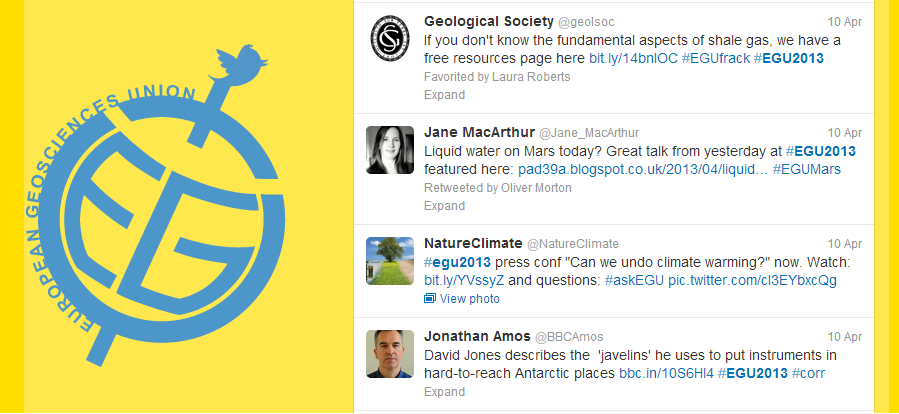With the mammoth task of Storifying #EGU2013 this week, I’m wondering just how useful social media, particularly Twitter, has become at conferences.
While having a hashtag for a conference with 4,684 oral, 8,207 poster, and 452 PICO presentations (#EGU2013) won’t give you an insight into what’s going on in all the sessions – there’s simply too much science – it provides a guide to what’s happening next (as speakers share their sessions) and is an indicator of the “hot topics” as multiple media-savvy participants share their experience of particular sessions. More importantly though, it gives people attending the conference an opportunity to interact and extend their discussion online.
When there’s over 3,800 tweets on the #EGU2013 hashtag during the General Assembly, curating a scintillating story that also falls into the category of ‘short and sweet’ no longer seems achievable. But do we need it? Perhaps it’s better to preserve the discussion that surrounds topical sessions such as the Great Debate on fracking and shale gas (Storify to come – watch this space!) and short courses, which can then be used as a resource for hints and tips later.
While making something public via Twitter can bring up the subject of potentially being “scooped” on science before it’s published. At a conference you are already communicating your work externally, so this is not an issue. Instead, it presents an opportunity to communicate your research with the wider public and scientific community. Here are some of the benefits:
Enriched discussions
Twitter provides opportunities for a much richer discussion during a conference – not only are you listening to the speaker’s insights on a topic, but you can tune in to the knowledge and experience of others in the audience. The knowledge gathered in a scientific conference is phenomenal and in the case of the EGU General Assembly, having over 11,000 brilliant scientific minds at your fingertips, why wouldn’t you ask a question?! Okay, so they aren’t all on Twitter, but the chance of a well-informed reply is high, so it’s still worth asking!
Remote participation
To add to the already enriched discussion, when something is being broadcast on Twitter, anyone can follow the goings on – be it the colleagues you left back in the lab, the geologist whose fieldwork clashed with the event, or the interested twitterer, who happens upon the hashtag! If a talk is being live tweeted (someone is tweeting updates about the speaker’s presentation) then it’s even easier for others to participate in the conference online and ask their own questions of the audience and the speaker.
Leaving a legacy
So we have a rich discussion, that involves members of the audience and connects with the wider public, potentially sharing the science with individuals across the globe – is there more to gain from a conference Twitter feed? Yes. The online discussion can be condensed and curated using Storify, which leaves a legacy of the discussion that people can return to later. Take the #EGUjobs session for example, Sarah Blackford and Helen Goulding gave an excellent talk on how to apply for jobs both in and out of academia last week and you can return to their recommendations here.
What did you gain from the conference Twitter feed? Fancy more of the same next year? Less? Or an even bigger online presence in 2014? Leave a comment below, or include it in the conference feedback form and we’ll do our best to make it a reality.


Jon Tennant
So the way to deal with 1700 tweets is to break them down into smaller manageable chunks. Next year, I’d recommend asking each session convener to have a separate hash-tag for their talks, as well as separate ones for poster sessions and other sectors. Each one of these can then be covered independently, and stops everything being a mish-mash in the one feed. So the example to follow would be the SpotOn London feeds from 2012. If conveners don’t want to do this small task, then it’s their loss – they lose the broader online coverage of their sessions, and keep their science locked away in conference-based ivory towers. *shrug*
David Pyle
The beauty of a single hashtag is that the reader/follower can immediately capture everything that is going on. I don’t see too much value in having additional/different hashtags except perhaps for the one or two events that are likely to generate a lot of traffic (e.g. those with casts of thousands, or those likely to engage the social media afficionados). I convened a session this year, had a good turnout of 50-70 people for most of a day, but there were only 2 tweeters reporting the session – and I can’t see that value in having an extra hashtag just for this.
Jennifer Price
I agree with the separate hash tags idea, if not possible for each session then at least to have hash tags by discipline instead. This would make it easier to keep up with what’s going on.